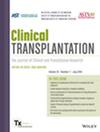Perioperative Timing Impacts Renal Graft Outcomes in Simultaneous Heart-Kidney Transplantation
Abstract
Background
Simultaneous heart-kidney (SHK) transplantation is widely administered as a treatment for end-stage cardiorenal disease. However, the impact of renal transplant timing as a concurrent (heart and kidney transplanted simultaneously) or staggered (heart transplant followed by kidney transplant) procedure on post-transplant outcomes has not been investigated.
Methods
We conducted a retrospective analysis of the UNOS STAR for SHK transplants that occurred in the United States between 2010 and 2024. Institutional SHK transplant data were similarly reviewed for specific patient-level factors.
Results
Approximately two-thirds (N = 1668) of SHK transplants were performed using the staggered approach, with the remaining one-third performed concurrently (N = 868). Univariate analysis of concurrent versus staggered SHK transplants indicated that staggered SHK transplant was associated with a higher rate of delayed graft function (DGF; 31.4 vs. 25.6%, respectively; p = 0.003) and lower 1-year renal graft survival (89.9 vs. 84.5%, respectively; p < 0.001). A multivariable regression analysis showed that these differences in DGF (HR 1.29, 95% CI 1.05–1.58, p = 0.014) and 1-year graft survival (HR 1.39, 95% CI 1.05–1.83, p = 0.020) remained when other factors were controlled. In multivariable Cox analysis, staggered SHK was associated with lower overall patient survival (HR 0.81, p = 0.045) but no differences in death-adjusted graft survival or need for renal retransplantation (both p > 0.05).
Conclusions
The results from this study indicate that discrepant outcomes in SHK transplantation result from the timing of renal transplantation, with concurrent SHK demonstrating superior outcomes in a large national dataset.

 求助内容:
求助内容: 应助结果提醒方式:
应助结果提醒方式:


